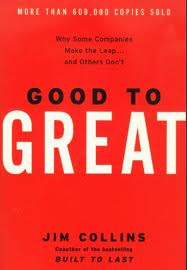Good to Great: Why Some Companies Make the Leap…and Others Don’t

– By Jim Collins
Good to Great was a monster best seller when it was released in 2001. It still retains its popularity and I am sure that many members of BlueBarn would have read the book.
Collins’ exhaustive research for the book was initiated to find out how some companies transition from being ‘good’ to ‘great’ and how others fail to make that transition. He defined (or found) great companies as those that ‘attained extraordinary results, averaging cumulative stock returns 6.9 times the general market in the fifteen years following their transition points…These are remarkable numbers, made all the more remarkable when you consider the fact that they came from companies that had previously been so utterly unremarkable.’
After examining the financial performance of hundreds of companies, Collins identified the following companies that had transitioned from being good to becoming great – Abbott, Circuit City, Fannie Mae, Gillette, Kimberly-Clark, Kroger, Nucor, Philip Morris, Pitney Bowes, Walgreens and Wells Fargo. He also contrasted these companies to a selected set of ‘comparison companies.’
From the study of the eleven companies (and their eleven average companions), Collins arrived at the characteristics that distinguished ‘Good to Great’ companies:
- Level 5 Leadership: Leaders who are humble, but driven to do what’s best for the company. The leaders of good-to-great companies were not superstars; on the contrary, they were self-effacing, diffident and shy.
- First Who, Then What: Rather than setting a vision as a starting point for their companies, the first thing that good-to-great leaders did was to get the right people on the bus and in the right positions. Equally importantly, they got the wrong people off the bus.
- Confront the Brutal Facts (Yet Never Lose Faith): Good-to-great companies embraced the Stockdale Paradox. Admiral Jim Stockdale was the highest ranking US prisoner-of-war during the Vietnam War. Imprisoned and tortured during his eight years in captivity, Admiral Stockdale survived by understanding the reality of his situation but never giving up hope. In the same way, some of the good-to-great companies confronted the brutal truth of their situation but never gave up hope.
- Hedgehog Concept: Good-to-great companies embraced a simple, clear-cut concept based on the interaction of three questions:
- What are you deeply passionate about?
- What can you be the best in the world at?
- What drives your economic engine?
The focus on that simple concept at the intersection of the three questions (circles) drove the good-to-great companies.
- A Culture of Discipline: Most companies have a culture but very few have a culture of discipline, something that Collins’ researched showed was consistent amongst all the good-to-great companies. This meant that only the system needed to be handled, not the very disciplined people within the organisation.
- Technology Accelerators: Using technology to accelerate growth, within the three circles of the hedgehog concept.
- The Flywheel and the Doom Loop: Good-to-great companies rarely had revolutions or massive restructuring or dramatic change programmes. On the contrary, they were built on the cumulative effect of many small initiatives. The steady build-up was akin to small savings compounding into a big sum.
Prior to Good to Great, Jim Collins had written, with Jerry Porras, the interesting and equally influential Built to Last. While Built to Last looked at companies that had shown sustained great results and had become visionary, Good to Great examined how average companies had become great. To that extent, Good to Great is more a prequel rather than a sequel to Collins’ earlier book.
Good to Great presents a very clear-cut road map for companies to move from being just average or good to becoming truly great. And therein lies its big attraction; I know of a couple of leaders who have used – in the companies that they joined – the exact steps that Collins has identified in his book.
Yet, the problem with Collins’ book is similar to the problem that In Search of Excellence faced – some of the good-to-great companies that he identified are today neither good nor great. Circuit City is defunct, Fannie Mae almost went bankrupt and some of the companies have shown fairly poor results in recent years. In fact, if someone had invested (in 2001, the year the book came out) in the eleven companies identified by Collins, he would find that his eleven companies would underperform the S&P 500. Steven Levitt criticised Good to Great as being backward looking and not necessarily providing a guide for the future. Recently, in HBR, Raynor and Ahmed wrote that Good to Great (as well as In Search of Excellence) did not provide the right insights because they did not look at the element of chance in the outstanding performance of the great/exceptional companies.
Rating: A
